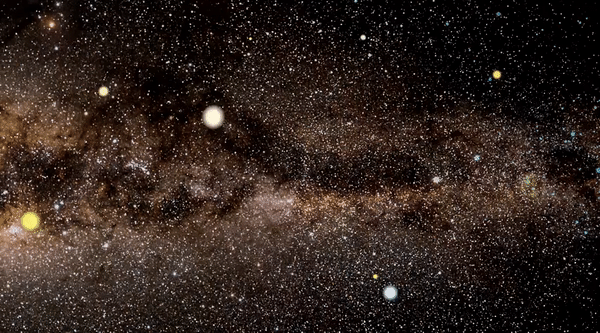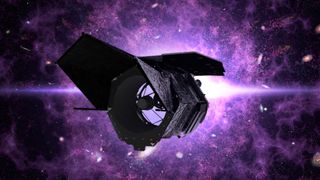A rogue planet is a world that has been ejected from the planetary system in which it originally formed.
Because rogue planets do not orbit a parent star, they are cast adrift into interstellar space. On their meanderings, rogue planets are pulled toward whatever large, gravitationally attractive body they happen to pass by.
Most rogue planets are ejected during the early stages of planetary formation when planetary systems are more chaotic and there is more interaction among planets, David Bennett, a senior research scientist at NASA’s Goddard Space Flight Center, told Space.com. However, the instabilities in orbits and the uncertainties in the interactions between planets mean that unlucky worlds can be hurled into the abyss of space throughout the lifetime of any planetary system.
“This ejection process never actually stops,” Bennett said. “It just slows down.” – – David Bennett, Senior research scientist at NASA’s Goddard Space Flight Center
Binary star systems may provide a steadier supply of rogue worlds to the barren desert of interstellar space than single star systems like our own do, Bennett noted.
“It seems likely, though, that planets in binary stellar systems are likely to eject more planets than single star systems,” Bennett said. “This is even the case for very wide binary star systems. The eccentricity of very wide stellar obits can be perturbed by passing stars, which will occasionally send the two stars very close to each other to cause more ejection or even to steal planets from its binary companion.”
How many rogue worlds are in the Milky Way?
The most recent estimation of the number of rogue planets in the Milky Way suggests there are about 20 rogue planets for every star in the galaxy. Current estimates of the number of stars in the Milky Way range from 100 billion to 400 billion. So, if we assume there are 200 billion stars in the Milky Way, which is a reasonable estimate, then there could be a whopping 4 trillion rogue planets wandering our galaxy.
In a 2022 study estimating the number of rogue worlds in the galaxy, Bennett and colleagues suggested that most of these free-floating planets are worlds with roughly the mass of Earth, or even less, rather than heavier gas giants like Jupiter and Saturn. Heavier worlds would need larger gravitational instabilities to get flung from their orbits.
“The apparent excess of very-low-mass rogue planets is what we expect from ejection from planet-planet interaction,” Bennett said.
How do astronomers detect rogue worlds, and how many have we discovered?

Young, massive rogue planets as large as Jupiter and beyond can be detected via their own light. However, another method, known as gravitational microlensing, allows astronomers to identify low-mass rogue planets. The advantage of this technique is that astronomers can detect these worlds via their gravitational effects rather than by observing their light directly.
Astronomers often infer the existence of an exoplanet from the gravitational “wobble” it exerts on its home star or when it passes between us and the hypothesized planet’s home star. When this happens, the light from the star behind the planet is gravitationally lensed, magnifying the light from the star behind it. The greater the mass of the object between Earth and the light-emitting object, the greater the lensing effect.
To observe these lensing events, astronomers have to keep a constant close eye on stars in the hope that something will pass between us and the star. Astronomers have used this technique to identify not only exoplanets that orbit stars but also free-floating worlds adrift in the cosmos.
A recent example of this was the Microlensing Observations in Astrophysics (MOA) survey, which observed specific stars for almost a decade. The survey, conducted by astronomers from NASA and Japan’s Osaka University, provided the data for the most up-to-date estimates of the number of rogue worlds.
From microlensing, which is the main method for detecting rogue planets, “there are maybe 25 rogue planet detections,” Bennett said.
Are they dangerous?
Given that there are estimated to be trillions of rogue planets in our galaxy, it might be reasonable to think they pose a significant threat to the stability of the solar system — or even to Earth itself if one were to pass too close.
However, Bennett said it’s “not very likely” that a rogue planet would enter the solar system and disrupt it. Despite the vast number of rogue worlds in the galaxy, there is plenty of space between stars for these worlds to not pose too much of an existential threat to Earth and the rest of the solar system.
Previous worries that this scenario could unfold were based on the idea of a rogue planet the size of Jupiter entering the solar system. However, astronomers now believe the vast majority of rogue worlds are smaller. Earth-size rogue planets would likely have less of a destabilizing influence if they were to pass close by.
How will future observations further our understanding of rogue planets?

Bennett will be the principal investigator, alongside Scott Gaudi of The Ohio State University, of the Roman Galactic Exoplanet Survey. The survey, which will be conducted by the Nancy Grace Roman Space Telescope, has the potential to observe 400 Earth-mass rogue planets, based on the findings of the MOA survey.
Bennett said his team will look to use ground-based observatories, such as the Vera C. Rubin Observatory, alongside Roman.
“Rubin will not have a high enough observing cadence to make convincing detections of rogue planets itself,” Bennett said. “But it will be able to help make mass measurements of the rogue planets detected by Roman. The light curves will look different to observers on Earth than it will to Roman in its L2 halo orbit, and this difference can help determine the rogue planet mass.”.
Through new observational opportunities with Roman, Rubin and perhaps the European Space Agency‘s (ESA) Euclid telescope, astronomers hope to get a better understanding of the mass distribution of rogue planets, as well as obtain more data to help constrain their estimates of the number of free-floating worlds in our galaxy.
“We are particularly interested in getting ESA’s Euclid telescope to help with this, since the difference between Euclid’s and Roman’s L2 halo orbits will also be enough to see this ‘microlensing parallax‘ effect that we will use to get the masses,” Bennett said.
Additional resources
Animators associated with NASA created this short visualization of a rogue world hurtling through space. Researchers have also discussed the possible conditions where rogue planets or their moons could potentially sustain life. You can find an in-depth discussion on the possibility of whether life and liquid water could exist on rogue planets’ moons from the University of Cambridge Press. Scientists have also speculated about the possibility of advanced technological civilizations using rogue planets as a means of traveling through interstellar space.
Bibliography
Balzer, Ashley. New Study Reveals NASA’s Roman Could Find 400 Earth-Mass Rogue Planets. NASA, 19/07/23, https://www.nasa.gov/missions/roman-space-telescope/new-study-reveals-nasas-roman-could-find-400-earth-mass-rogue-planets/
Euclid Exploring the dark Universe, The European Space Agency, [Accessed 6/16/24] [https://www.esa.int/Science_Exploration/Space_Science/Euclid]
Nancy Grace Roman Space Telescope, NASA, [Accessed 6/16/24] [https://roman.gsfc.nasa.gov/]
Roccetti G, Grassi T, Ercolano B, et al. Presence of liquid water during the evolution of exomoons orbiting ejected free-floating planets. International Journal of Astrobiology. 2023;22(4):317-346. doi:10.1017/S1473550423000046
Rogue Planet Animation, NASA, [Accessed 6/16/24] [https://svs.gsfc.nasa.gov/13644]
Romanovskaya IK. Migrating extraterrestrial civilizations and interstellar colonization: implications for SETI and SETA. International Journal of Astrobiology. 2022;21(3):163-187. doi:10.1017/S1473550422000143
Sumi T, Koshimoto N, Bennett D, et al. 2023. Free-floating Planet Mass Function from MOA-II 9 yr Survey toward the Galactic Bulge. The Astronomical Journal, vol. 166, Institute of Physics, no. 3, pp 108-108. doi: 10.3847/1538-3881/ace688
The Microlensing Observations in Astrophysics (MOA) Collaboration., The Optical Gravitational Lensing Experiment (OGLE) Collaboration. Unbound or distant planetary mass population detected by gravitational microlensing. Nature 473, 349–352 (2011). https://doi.org/10.1038/nature10092
Vera C. Rubin Observatory, [Accessed 6/16/24] [https://rubinobservatory.org/]






